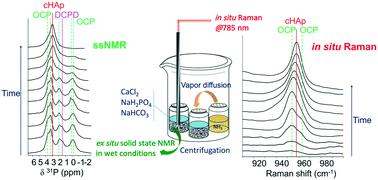当前位置:
X-MOL 学术
›
CrystEngComm
›
论文详情
Our official English website, www.x-mol.net, welcomes your
feedback! (Note: you will need to create a separate account there.)
Insights into OCP identification and quantification in the context of apatite biomineralization
CrystEngComm ( IF 2.6 ) Pub Date : 2020-03-05 , DOI: 10.1039/c9ce01972c Marc Robin 1, 2, 3, 4, 5 , Stanislas Von Euw 1, 2, 3, 4, 5 , Guillaume Renaudin 2, 6, 7, 8, 9 , Sandrine Gomes 2, 6, 7, 8, 9 , Jean-Marc Krafft 1, 2, 10, 11, 12 , Nadine Nassif 1, 2, 3, 4, 5 , Thierry Azaïs 1, 2, 3, 4, 5 , Guylène Costentin 1, 2, 10, 11, 12
CrystEngComm ( IF 2.6 ) Pub Date : 2020-03-05 , DOI: 10.1039/c9ce01972c Marc Robin 1, 2, 3, 4, 5 , Stanislas Von Euw 1, 2, 3, 4, 5 , Guillaume Renaudin 2, 6, 7, 8, 9 , Sandrine Gomes 2, 6, 7, 8, 9 , Jean-Marc Krafft 1, 2, 10, 11, 12 , Nadine Nassif 1, 2, 3, 4, 5 , Thierry Azaïs 1, 2, 3, 4, 5 , Guylène Costentin 1, 2, 10, 11, 12
Affiliation

|
Calcium phosphates (CaPs) are one of the major mineral families of wide interest in biomineralization and biomaterial development. The identification and quantification of the different CaP phases (crystalline and amorphous) remains a major challenge in both in vitro and in vivo systems. This work aims to provide critical analysis of the different analytical techniques, Raman spectroscopy, solid-state NMR spectroscopy (ssNMR) and X-ray diffraction (XRD), which are used for the discrimination of octacalcium phosphate (OCP) from hydroxyapatite (HAp). Low amounts of OCP (∼10 wt%) can be detected by Raman spectroscopy in the presence of biomimetic carbonated apatite (cHAp), provided that the ν(HPO4) contribution with weak intensity from OCP at 1008 cm−1 is observable or that the spectral decomposition of the overlapped ν1(PO4) bands from OCP and cHAp is performed. However, Raman is not suitable for quantification purposes. In contrast, the quantification of OCP in proportions down to 10 wt% is easily performed with 31P solid state NMR. Opposite to solid state NMR, Raman can be implemented under in situ conditions to monitor the time dependence of the biomineralization process without any sampling perturbation. An approach combining the advantages of in situ micro-Raman spectroscopy and the sensitivity of ex situ solid state NMR was used to monitor the formation of biomimetic carbonated apatite from an acidic aqueous solution of phosphate, carbonate and calcium ions. In relation with the progressive increase of pH, we identify the transient phases, the precursors of cHAp: it is shown that an amorphous calcium phosphate phase (ACP) is first formed and subsequently transforms into OCP that then progressively turns into cHAp. Finally, powder X-ray diffraction coupled to Rietveld refinement was found to be very powerful in quantifying very small amounts of residual OCP in cHAp (down to 2 wt%). Upon the OCP transformation into cHAp, the decrease of the relative intensity of the (100) diffraction peak of the transient OCP phase was ascribed to an alteration of its hydrated layers, related to incorporation of water molecules and/or carbonate anions with reaction time. Such carbonate uptake in the course of transformation of OCP into cHAp could explain the origin of carbonate substitutions in the final biomimetic carbonated apatite.
中文翻译:

磷灰石生物矿化中对OCP鉴定和定量的见解
磷酸钙(CaPs)是生物矿化和生物材料开发中广泛关注的主要矿物家族之一。在体外和体内系统中,不同CaP相(结晶相和非晶相)的鉴定和定量仍然是主要挑战。这项工作旨在提供对不同分析技术的严格分析,这些技术包括拉曼光谱,固态NMR光谱(ssNMR)和X射线衍射(XRD),用于区分磷酸八钙(OCP)和羟基磷灰石(HAp)。 。如果存在仿生的碳酸磷灰石(cHAp),可以通过拉曼光谱法检测到少量的OCP(〜10 wt%),前提是ν(HPO 4)与来自OCP弱强度的贡献在1008厘米-1是可观察到的或重叠的频谱分解ν 1(PO 4执行从OCP和CHAP)频带。但是,拉曼不适用于定量目的。相反,使用31 P固态NMR可以轻松进行低至10 wt%的OCP定量。与固态NMR相反,拉曼可以在原位条件下实施以监测生物矿化过程的时间依赖性,而无需任何采样扰动。的方法相结合的优点原位微拉曼光谱和灵敏度易地固态NMR用于监测由磷酸盐,碳酸盐和钙离子的酸性水溶液形成的仿生碳酸磷灰石的形成。关于pH的逐步增加,我们确定了过渡相,即cHAp的前体:显示出先形成无定形磷酸钙相(ACP),然后转化为OCP,然后逐渐转化为cHAp。最后,发现粉末X射线衍射与Rietveld精制相结合,在定量cHAp中非常少量的残留OCP(低至2 wt%)方面非常有效。OCP转变为cHAp后,瞬态OCP相的(100)衍射峰的相对强度降低归因于其水合层的改变,与在反应时间中结合水分子和/或碳酸根阴离子有关。在OCP转化为cHAp的过程中,此类碳酸盐的吸收可能解释了最终的仿生碳酸盐磷灰石中碳酸盐替代的起源。
更新日期:2020-03-05
中文翻译:

磷灰石生物矿化中对OCP鉴定和定量的见解
磷酸钙(CaPs)是生物矿化和生物材料开发中广泛关注的主要矿物家族之一。在体外和体内系统中,不同CaP相(结晶相和非晶相)的鉴定和定量仍然是主要挑战。这项工作旨在提供对不同分析技术的严格分析,这些技术包括拉曼光谱,固态NMR光谱(ssNMR)和X射线衍射(XRD),用于区分磷酸八钙(OCP)和羟基磷灰石(HAp)。 。如果存在仿生的碳酸磷灰石(cHAp),可以通过拉曼光谱法检测到少量的OCP(〜10 wt%),前提是ν(HPO 4)与来自OCP弱强度的贡献在1008厘米-1是可观察到的或重叠的频谱分解ν 1(PO 4执行从OCP和CHAP)频带。但是,拉曼不适用于定量目的。相反,使用31 P固态NMR可以轻松进行低至10 wt%的OCP定量。与固态NMR相反,拉曼可以在原位条件下实施以监测生物矿化过程的时间依赖性,而无需任何采样扰动。的方法相结合的优点原位微拉曼光谱和灵敏度易地固态NMR用于监测由磷酸盐,碳酸盐和钙离子的酸性水溶液形成的仿生碳酸磷灰石的形成。关于pH的逐步增加,我们确定了过渡相,即cHAp的前体:显示出先形成无定形磷酸钙相(ACP),然后转化为OCP,然后逐渐转化为cHAp。最后,发现粉末X射线衍射与Rietveld精制相结合,在定量cHAp中非常少量的残留OCP(低至2 wt%)方面非常有效。OCP转变为cHAp后,瞬态OCP相的(100)衍射峰的相对强度降低归因于其水合层的改变,与在反应时间中结合水分子和/或碳酸根阴离子有关。在OCP转化为cHAp的过程中,此类碳酸盐的吸收可能解释了最终的仿生碳酸盐磷灰石中碳酸盐替代的起源。









































 京公网安备 11010802027423号
京公网安备 11010802027423号